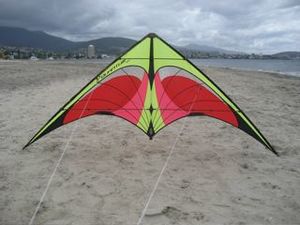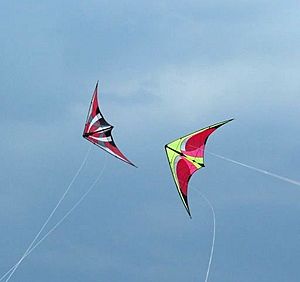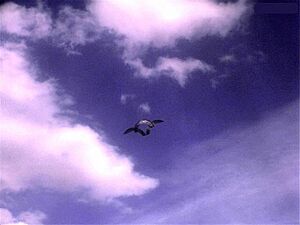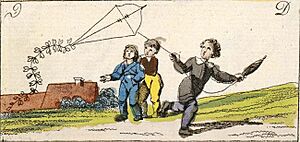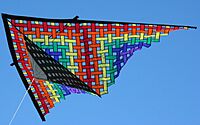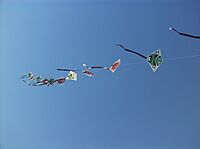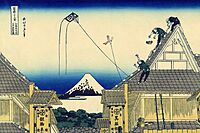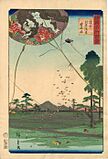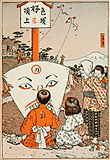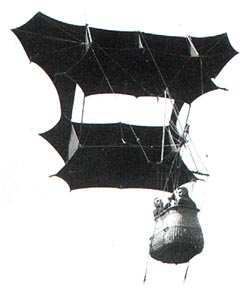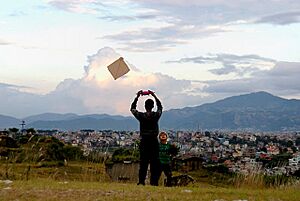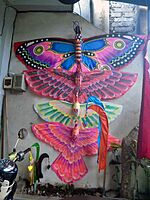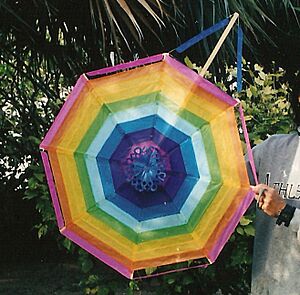Kite facts for kids
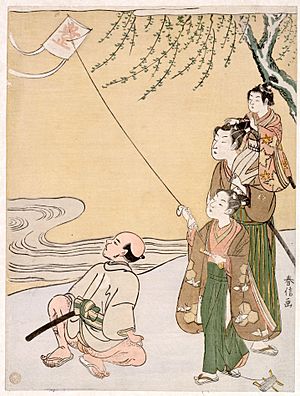
A kite is a cool flying object that uses the wind to stay up in the air! You hold it with a string, and the wind pushes against its surface, making it soar. Most kites have wings, strings (called tethers), and a spot where the string attaches. Many also have a bridle (a set of strings that helps the kite face the wind) and a tail. These parts help the kite catch the air just right so it can fly high. The word "kite" actually comes from a type of bird that can float in the air.
Kites fly because of two main forces:
- Lift: This is the force that pushes the kite upwards. It happens when air moves faster over the top of the kite and slower underneath, creating different pressures that push it up.
- Drag: This force pulls the kite in the direction the wind is blowing.
Kites have a super long and interesting history. People fly them for fun, as amazing art, or for many practical reasons. You can see them at awesome festivals all over the world. Some kites are made for sports, like aerial "ballet" competitions where they perform tricks. Others, called power kites, are super strong and can pull people for exciting activities like kite surfing or snow kiting!
Contents
Types of Kites
There are many different shapes and sizes of kites! Some common types include:
- Flat kites: These are simple, often diamond-shaped kites.
- Bowed kites: These have a slight curve to help them fly.
- Box kites: These are made of several boxes joined together.
- Delta kites: These look like a triangle or the Greek letter delta.
- Power kites: These are large, strong kites used to pull people.
- Stunt kites: These kites have two or more lines, letting you control them to do tricks.
Kites are also used for kite aerial photography, which means taking pictures from the sky!
Materials Used to Make Kites
Kites need to be light enough to fly but strong enough to handle the wind.
In the past, people often used materials like paper and silk for the kite's "sail" (the part that catches the wind). Paper was cheap and light, but it could get damaged by water easily. Silk was much stronger for its weight, flexible, and could be dyed bright colors, making beautiful kites. Silk was more expensive than paper.
Today, most kites are made from modern, super-strong fabrics like ripstop polyester and ripstop nylon. These materials are great because they are very durable, don't get damaged by water easily, and are super strong but still lightweight.
Thin plastic films, like polyethylene (the plastic in grocery bags) or polyester film (like Mylar®), are often used for simpler or cheaper kites you might find in toy stores. They are very light and waterproof, but can sometimes tear more easily than fabric kites.
The frame, or "skeleton," gives the kite its shape. It needs to be light but also strong and flexible enough to handle the wind without breaking. The rods or sticks that make up the frame are called spars.
Historically, natural materials like bamboo and wood were used for frames. Bamboo is a fantastic traditional material, especially in Asia where kites began. It's light, strong, and naturally flexible. Lightweight woods like balsa wood were also used.
Modern kites use amazing new materials for their frames:
- Fiberglass: These rods are very popular because they are lightweight, strong, and very flexible. They can bend a lot in the wind without breaking and then snap back to their original shape.
- Carbon fiber: This material is even lighter and stronger than fiberglass, but it's usually more expensive. It's used in high-performance kites, like big power kites, where being super light and strong is really important.
History of Kites
Kites are believed to have been invented in China around 2,500 years ago! Two philosophers, Mozi and Lu Ban, are often given credit. China had perfect materials for kites: silk for the wings, strong silk for the lines, and light, tough bamboo for the frame.
By 549 AD, people were definitely flying paper kites. One story says a paper kite was used to send a message during a rescue mission. Ancient Chinese records show kites were used for measuring distances, checking wind, lifting people, and sending signals in military operations. Many Chinese kites were decorated with mythical creatures and figures, and some even had strings and whistles to make music in the sky!
Kites eventually traveled to India, where they developed into the fighter kite, known as the patang. Thousands of these kites are flown every year during festivals like Makar Sankranti.
Kites also spread across Polynesia, reaching as far as New Zealand. People in these areas used kites made from cloth and wood in religious ceremonies to send prayers.
Kites arrived later in Europe. Marco Polo brought stories of kites back in the late 1200s, and sailors brought actual kites from Japan and Malaysia in the 1500s and 1600s. At first, Europeans saw kites as just interesting toys. But by the 1700s and 1800s, they started using kites for scientific research.
In 1752, Benjamin Franklin famously used a kite in an experiment to show that lightning was a form of electricity.
Kites were also very important for the Wright brothers and others who were trying to build the first airplane in the late 1800s. They experimented with different man-lifting kite designs. The time from 1860 to about 1910 is sometimes called the "golden age of kiting" in Europe.
In the 20th century, many new kite designs appeared, like the tetrahedral kite and power kites. Kites were used for science, especially in studying weather, flight, and even for taking pictures from the air.
Today, kites are mostly flown for fun. Modern kites are made from lightweight, strong materials like ripstop nylon and carbon fiber. The lines are made from super-strong synthetic ropes.
Gallery
-
Kites flying above a shop in Edo, Japan, by Hokusai.
How Kites Are Used
Kites have been used for many different things, including lifting people, military tasks, scientific research, photography, lifting radio antennas, and even generating electricity!
Military Uses
In the past, kites were used by the military for signaling, carrying supplies, and for observation. They could lift a person high above a battlefield or be used for taking pictures from the air.
The Chinese were the first to use kites in warfare. During the Song dynasty, they developed the "Fire Crow," a kite that carried burning powder as a weapon. In Korea, General Kim Yu-sin used flaming kites in 647 to scare enemies and encourage his troops.
Later, in Europe, there are records of kites being used to carry firebombs over city walls. Admiral Yi of Korea also used kites with special markings to give orders to his navy during battles in the late 1500s.
In more modern times, the British Army used kites to lift human observers. During World War II, barrage kites were used to protect ships, and kites were also used for target practice. Kites were even used to lift antennas for radio communication.
Science and Weather
Kites have been important for science. Benjamin Franklin's famous experiment with lightning is a great example. Kites also helped in the early development of airplanes. Scientists like Alexander Graham Bell and the Wright brothers used large kites in their research. Kites were historically used to carry instruments high into the air to measure weather conditions, which helped with weather forecasting.
Radio Antennas and Lights
Kites can be used to lift radio antennas high into the air for better signal. This was done for the first transatlantic radio transmission by Guglielmo Marconi. Kites can also carry lights, like glow sticks or battery-powered lights, making them visible at night.
Kite Power

Kites can be used to pull people and vehicles! Strong foil-type kites, called power kites, can generate a lot of force. This power is used in sports like kite buggying (pulling a buggy), kite landboarding (pulling a skateboard with big wheels), kite boating, and kite surfing (pulling a person on a board across water). Snow kiting is also popular, where kites pull people on skis or snowboards.
Kite power offers some cool advantages:
- Winds are stronger higher up in the sky.
- Kites can be moved around to create even more pulling force.
- Vehicles can be very light because they don't need heavy structures to hold up sails.
Generating Electricity
Some companies are developing computer-controlled kites to generate electricity. These kites can fly high to catch strong winds, and the power they generate can be stored in batteries. This is a way to get clean energy, especially in remote areas.
Underwater Kites
Underwater kites are now being developed to create renewable energy from water currents. A "water kite" was also used in minesweeping during World War I to help submerge wires to the correct depth.
Kites in Culture
Kite festivals are popular events around the world. These can be big local gatherings, traditional festivals that have happened for hundreds of years, or large international events where kite flyers from different countries show off their amazing art kites and new technical designs.
Many countries have museums dedicated to kites, often focusing on their history and traditions.
Asia
Kite flying is very popular in many Asian countries. Often, it involves "kite fighting," where people try to snag or cut down each other's kites. These fighter kites are usually small, diamond-shaped, and made of paper and bamboo. They don't have tails, which makes them very agile.
In Afghanistan, kite flying is a popular game called Gudiparan Bazi. Some kite fighters use strings coated with ground glass and glue to cut other kites more easily. This can be dangerous. During the Taliban rule, kite flying was banned.
In Pakistan, kite flying is known as Gudi-Bazi or Patang-bazi. It's a popular part of the spring festival, Jashn-e-Baharaan (Spring Festival) or Basant, but kites are flown all year. Kite fighting is very popular, especially in cities like Lahore. When someone cuts another kite's string, people shout 'wo kata'! People then chase after the cut kites. This is shown in the 2007 film The Kite Runner.
In Indonesia, kites are flown for sport and fun. Balinese kites are famous for their unique designs, often looking like birds, butterflies, or dragons. In Vietnam, kites are flown without tails, but with small flutes attached that "hum" a musical tune in the wind. Other kites make sounds too, like the large bows on Balinese kites that create a deep vibration. Malaysia even has a Kite Museum in Malacca.
Kites are also popular in Nepal, especially during the August-September period and the Dashain festival.
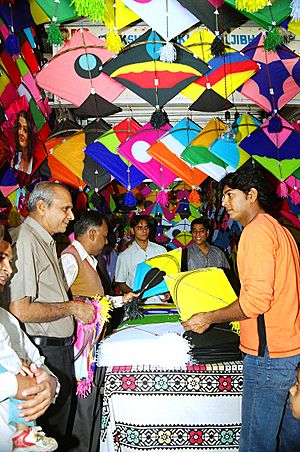
In India, kite flying is huge, especially in states like Gujarat and Uttar Pradesh. People fly highly maneuverable single-string kites from rooftops, trying to cut each other's lines. During the Makar Sankranti festival in January, millions of kites fill the sky across northern India. International kite festivals are held in cities like Vadodara and Ahmedabad.
Kites have been flown in China for a very long time. Weifang has the world's largest kite museum and hosts an annual international kite festival. There are also kite museums in Japan, the UK, Malaysia, Indonesia, Taiwan, Thailand, and the USA. In the past, Malays in Singapore even used kites for fishing.
In Japan, kite flying is a traditional children's activity during New Year holidays and the Boys' Festival in May. Some areas celebrate a new baby boy with a special "celebration kite." Japan has many kite festivals, with the "Yōkaichi Giant Kite Festival" being very famous. The largest kite there was over 62 feet wide and 67 feet high! In the Hamamatsu Kite Festival, parents fly kites with their baby's name on them.
Europe
In Greece and Cyprus, flying kites is a tradition on Clean Monday, the first day of Lent. In Bermuda, people make and fly traditional Bermuda kites at Easter, symbolizing Christ's ascent. In Fuerteventura, a kite festival is usually held in November.
Polynesia
Traditional Polynesian kites are used in ceremonies and for fun. Old kites are kept in museums and are highly valued.
-
A Māori kite.
South America
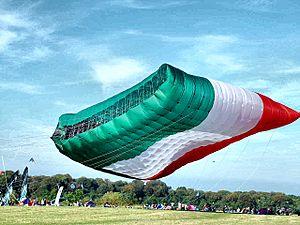
In Brazil, flying kites is a very popular hobby for kids and teenagers. It's often a game of kite fighting, where the goal is to cut the other person's kite string. Then, people race through the streets to catch the free-drifting kites.
In Chile, kites are very popular, especially around Independence Day (September 18). In Peru, kite festivals are held in parks and on beaches, mostly in August.
In Colombia, kites are flown in parks during August, which is known as the windy month.
In Guyana, kites are flown at Easter by everyone, regardless of background. The practice is thought to have been introduced by Chinese immigrants in the mid-1800s.
World Records
There are many world records for kites! The largest kites ever flown are usually inflatable single-line kites. The record for the largest kite flown for at least 20 minutes is "The Flag of Kuwait."
In 2011, a world record was set for the most kites flown at once: 12,350 kites flown by children on a beach in Gaza.
The record for the highest a single kite has flown belongs to a triangular-box delta kite. On September 23, 2014, a team flew a 129 square foot kite to 16,009 feet (about 3 miles) above the ground in Australia! The flight took about eight hours, and the height was measured using GPS.
Kite Flying Safety
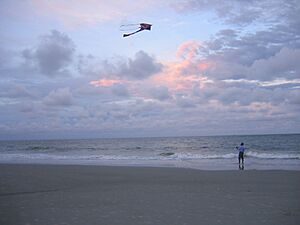
It's important to be safe when flying kites. Kite lines can get tangled in power lines, which can cause power outages and is very dangerous for the kite flyer. Wet kite lines or metal lines can conduct electricity, especially during storms or lightning. Very large kites can be so powerful that they can lift people off the ground or drag them into objects.
In cities, there are often limits on how high kites can fly to avoid interfering with helicopters and small aircraft. Sometimes, special kite strings used for fighting can be dangerous if they are coated with sharp materials.
Some governments have even banned kite flying in certain areas due to safety or security concerns.
See also
 In Spanish: Cometa (juguete) para niños
In Spanish: Cometa (juguete) para niños
- Airborne wind turbine, a concept for a wind generator that flies like a kite
- Kite aerial photography
- Kite buggying
- Kite fishing
- Kite ice skating
- Kite landboarding
- Kite shape
- Kiteboating
- Kitesurfing
- List of kite festivals
- Solar balloon, a balloon heated by the sun that can fly like a kite
- Uttarayan, a kite flying festival in western India
- Weifang International Kite Festival


